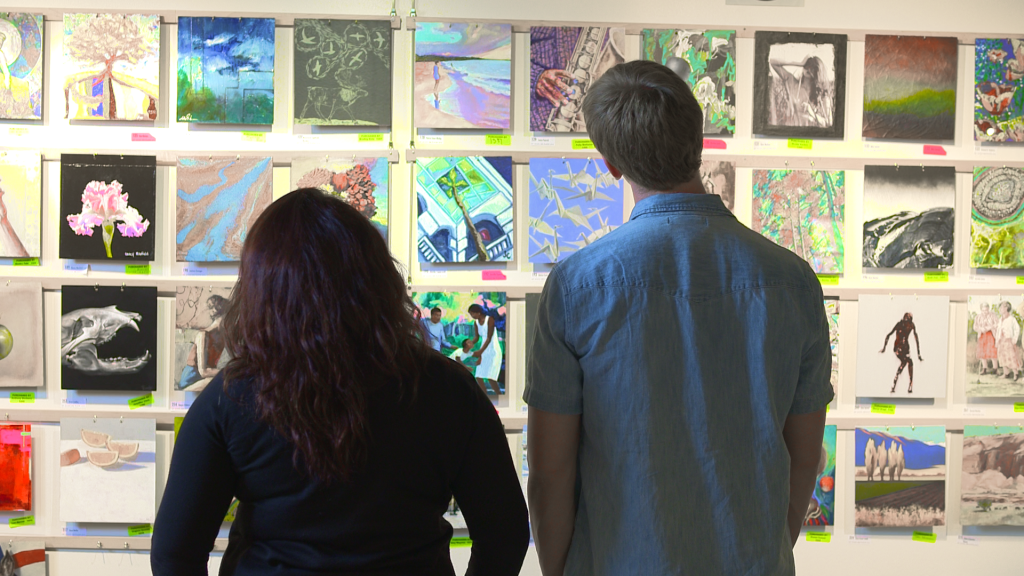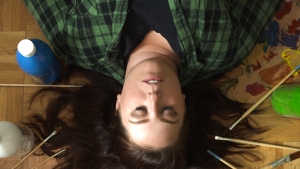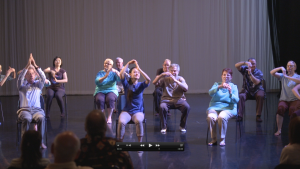Impressive as expected, the recent 14th annual PitchNic short film premieres by students at Spy Hop Productions engaged an audience of nearly 500 at the Rose Wagner Center for Performing Arts in many good questions following the screenings. More importantly, the quality of the films indicated that the student filmmakers are ready to submit their work to film festivals in Utah, the Intermountain West region and around the country.
Working with their mentors Josh Samson (fictional narrative) and Shannalee Otanez (documentaries), the students, all in their late teens, offered original work in every production aspect, including sound design and music. Conscientious and thoughtful, the students displayed an artistic sensitivity and sensibility that would be admired in any top-ranked university or college film production program.
Summary reviews are provided below for each of the four films:
Swerve (Katie Beacom, director; Stefan Pham, producer; and Daniel Duran, cinematographer)
One of the most solid fiction short films produced in PitchNic’s history, Swerve offers a credible unfiltered look at young people coming of age in a community where they have been raised to uphold Mormon values, a constancy of faith and the obligations of their missionary duties. The filmmakers temper the story less as a crisis of faith than as an earnest and aggressive search for trying to find a reasonable middle ground that accepts faith amidst differences of personal identity and behavior. Leaving it open-ended, the filmmakers portray the young woman at the center of the story as listening and absorbing the positive and negative experiences of her friends as she has second thoughts about whether or not she should go on her mission.
There is an understated tone about the characters who have diverged from a hardly attainable path of saintly perfectionism. There is a former boyfriend who smokes weed but who otherwise does not seem out of sorts. There is a friend who went on a Mormon mission but left the church after coming out as gay and thinking that there was no place for him in the community. There is a balance in the story, as one character talks positively about her missionary experience. This takes place as the main character goes on a trip and parties with her friends before she is scheduled to leave on her mission. During the trip, the young woman also discovers in a surprising way that her father, a by-the-book Mormon, is cheating on her mother.
It’s a worthy student film that should find audiences at film festivals – drawing variously on elements familiar to other solid coming-of-age films including The Perks of Being A Wallflower, The Squid and The Whale and Wild.
CO2 (Logan Rosson and Maddy Willardsen)
A quirky, effective documentary that mixes humor and animation with sober, even alarming interviews, this short film captures a fairly comprehensive overview of the aspects of Utah’s air pollution problem which is magnified every winter during persistent, longer stretches of smog inversions that push the Salt Lake City metropolitan area into the undistinguished rank as the nation’s city with the most polluted air. The film offers a good deal of information after opening with a clip montage of broadcast reports from last winter’s inversions, which were among the most severe persisting events in recent years.
One of the most prominent interviews is with Dr. Brian Moench, who represents Utah Physicians for Healthy Environment. While the film offers other interviews to amplify Moench’s warnings about the long-term public health implications of Utah’s air pollution, there also are other sources who downplay the dire consequences. They include a state economic development official who seeks to redirect the focus onto cleaner forms of energy development rather than on dealing with the implications that Moench extensively described. There also is a scene in which the filmmakers attempt to reach several Utah state legislators to comment on the issue but who refuse to return the calls.
In the Q&A following the screening, the filmmakers explained that they decided not to include footage from a utility spokesperson who insisted on extolling the virtues of clean coal while refusing to comment directly on the film’s central topic. The filmmakers should wisely decide to insert title cards in appropriate spots during the film to indicate and explain that they had sought to present a balanced slate of sources to discuss both sides of the issue. The film could be a solid addition to various regional and student film festivals.
Semblance (Noah Griffith co-producer and director; Daniel Duran, co-producer and co-director; and Brighton Ziegler, cinematographer)
A quiet, meditative short film, Semblance handles a young woman’s struggles with ADHD in a mature frame where the main character’s affirming epiphany about her artistic skills unfolds gradually. And, as with Swerve, the student filmmakers craft characters who are natural, even unassuming, yet convincing as credible in the story they are telling. The young woman gradually discovers that her creative propensity comes alive when she decides to skip her medication. She is shy – almost stubborn in her reticence – to let even those closest to her know that she has been painting.
The film, which is comparably sparser in dialogue than this year’s other fictional production, could be a bit tighter in pacing. Nevertheless, Semblance’s story echoes realistic experiences and the research of behavioral psychologists who see ADHD not as a disability but perhaps as an opening to a different pathway for eliciting an individual’s hidden talents and creative skills.
Dancing With Thorns (Mary Nejatifar, director, and Peque Curiel, cinematographer and editor)
An aptly titled film, this short documentary highlights three older adults with Parkinson’s disease who participate in a dance therapy program Grey Matters: Stretching the Mind, the Body and the Soul through Dance. It was started in early 2015 by the University of Utah’s departments of modern dance and physical therapy.
The film has a wonderful burst of youthful optimism, as the students capture their three subjects at ease talking about their symptoms and how the dance program has helped them deal with various symptoms. They intersperse interviews and scenes from the class with clips from a public performance and a chat with Juan Carlos Claudio, a university dance faculty member who is leading the program. It’s a warm, encouraging, personable look at an alternative therapy that shows how art and movement trumps the limits of labeling patients who find new ways to improve their motor skills and physiological functions and coordination.










Congratulations! Well done!